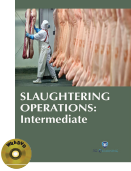Trade and Industrial Education

Slaughtering Operations: Intermediate comprehends various diverse practical and visual skills with knowledge of specialized materials and techniques. Animal slaughter is the killing of nonhuman animals, usually referring to killing domestic livestock. In general, the animals would be killed for food; however, they might also be slaughtered for other reasons such as being diseased and unsuitable for consumption. The animals most commonly slaughtered for food are cattle and water buffalo for beef and veal, sheep and lambs for lamb and mutton, goats for goat meat, pigs for pork and ham, deer for venison, horses for horse meat, poultry (mainly chickens, turkeys and ducks), and increasingly, fish in the aquaculture industry. This book will introduce the knowledge and skills for those studying and/or working in slaughtering industry to interpret and convey information in response to workplace requirements. About this Book The information in this book consists of competencies that a person must achieve in performing slaughtering floor operations from stunning of animals through splitting of the carcass. A person who has achieved this Qualification is competent to be Slaughterhouse Butcher. About the Slaughtering Industry.
In the process of slaughtering a deboning career involves slaughtering beef, sheep, goat, fish, pork and/or poultry by boning or deboning meat to meet compliance standards and targets. Slaughterers and meat packers work in slaughtering, meat packing, or wholesale establishments performing precision functions involving the preparation of meat. Work may include specialized slaughtering tasks, cutting standard or premium cuts of meat for marketing, making sausage, or wrapping meats. A high school diploma is required for a deboning career and advanced training in slaughtering operations may be preferred for some careers. One can find deboning jobs with large food processing companies, or may also work at smaller independent animal processing facilities. Overall employment of slaughterers, meat packers, and meat, poultry, and fish cutters and trimmers is projected to grow 3 percent from 2012 to 2022. Slaughtering and processing companies continue to consolidate their facilities and streamline production processes, which will limit the need for slaughterers and meat packers. Employment of meat, poultry, and fish cutters and trimmers is projected to grow 5 percent from 2012 to 2022, slower than the average for all occupations. As more people buy case-ready, prepared, or partially prepared meat products, there should be a need for these workers. Although processing facilities increasingly are using automation to raise productivity and efficiency, workers will continue to be needed to perform some functions of slaughtering, skinning, or cutting that is otherwise difficult to automate.